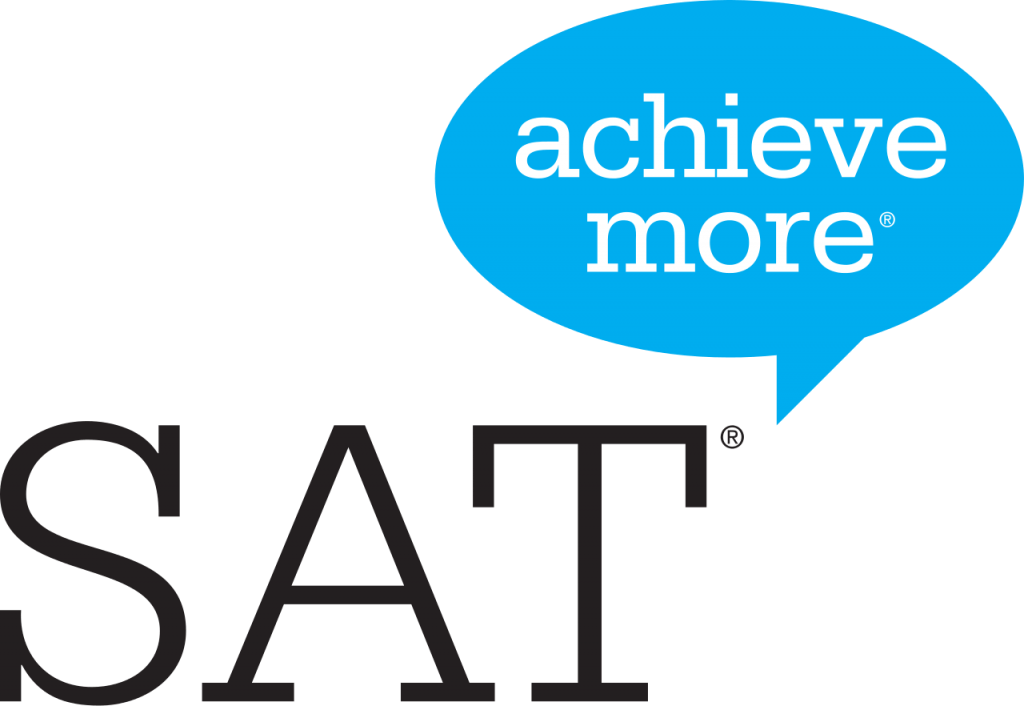
Reference : Wikipedia
SCHOLASTIC APTITUDE TEST
The SAT is wholly owned, developed, and published by the College Board, a private, not-for-profit organization in the United States. It is administered on behalf of the College Board by the Educational Testing Service, Which until recently developed the SAT as well. The test is intended to assess students’ readiness for college. The SAT was originally designed not to be aligned with high school curricula, but several adjustments were made for the version of the SAT introduced in 2016, and College Board president David Coleman has said that he also wanted to make the test reflect more closely what students learn in high school with the new Common Core standards
The SAT is typically taken by high school juniors and seniors. The College Board states that the SAT is intended to measure literacy, numeracy and writing skills that are needed for academic success in college. They state that the SAT assesses how well the test-takers analyze and solve problems—skills they learned in school that they will need in college. However, the test is administered under a tight time limit (speeded) to help produce a range of scores.
The College Board also states that use of the SAT in combination with high school grade point average (GPA) provides a better indicator of success in college than high school grades alone, as measured by college freshman GPA. Various studies conducted over the lifetime of the SAT show a statistically significant increase in correlation of high school grades and college freshman grades when the SAT is factored in. The predictive validity and powers of the SAT are topics of active research in psychometrics.
Historically, the SAT was more widely used by students living in coastal states and the ACT was more widely used by students in the Midwest and South; In recent years, however, an increasing number of students on the East and West coasts have been taking the ACT. Since 2007, all four-year colleges and universities in the United States that require a test as part of an application for admission will accept either the SAT or ACT, and as of Fall 2022, over 1400 four-year colleges and universities do not require any standardized test scores at all for admission, though some of them are applying this policy only temporarily due to the coronavirus pandemic.
The SAT takes three hours to finish and as of 2021 costs US$55.00, excluding late fees, with additional processing fees if the SAT is taken outside the United States. Scores on the SAT range from 400 to 1600, combining test results from two 200-to-800-point sections: the Mathematics section and the Evidence-Based Reading and Writing section. Although taking the SAT, or its competitor the ACT, is required for freshman entry to many colleges and universities in the United States,
The SAT has two main sections, namely Evidence-Based Reading and Writing (EBRW, normally known as the “English” portion of the test) and the Math section. These are both further broken down into four sections: Reading, Writing and Language, Math (no calculator), and Math (calculator allowed). The test taker was also optionally able to write an essay which, in that case, is the fifth test section.
The total time for the scored portion of the SAT is three hours (or three hours and fifty minutes if the optional essay section was taken). Some test takers who are not taking the essay may also have a fifth section, which is used, at least in part, for the pretesting of questions that may appear on future administrations of the SAT. (These questions are not included in the computation of the SAT score.)
Two section scores result from taking the SAT: Evidence-Based Reading and Writing, and Math. Section scores are reported on a scale of 200 to 800, and each section score is a multiple of ten. A total score for the SAT is calculated by adding the two section scores, resulting in total scores that range from 400 to 1600. In addition to the two section scores, three “test” scores on a scale of 10 to 40 are reported, one for each of Reading, Writing and Language, and Math, with increment of 1 for Reading / Writing and Language, and 0.5 for Math. There are also two cross-test scores that each range from 10 to 40 points: Analysis in History/Social Studies and Analysis in Science.
The essay, if taken, was scored separately from the two section scores. Two people score each essay by each awarding 1 to 4 points in each of three categories: Reading, Analysis, and Writing. These two scores from the different examiners are then combined to give a total score from 2 to 8 points per category. Though sometimes people quote their essay score out of 24, the College Board themselves do not combine the different categories to give one essay score, instead giving a score for each category.
There is no penalty or negative marking for guessing on the SAT: scores are based on the number of questions answered correctly. The optional essay will not be offered after the June 2021 administration.
The Reading Test of the SAT contains one section of 52 questions and a time limit of 65 minutes. All questions are multiple-choice and based on reading passages. Tables, graphs, and charts may accompany some passages, but no math is required to correctly answer the corresponding questions. There are five passages (up to two of which may be a pair of smaller passages) on the Reading Test and 10-11 questions per passage or passage pair. SAT Reading passages draw from three main fields: history, social studies, and science. Each SAT Reading Test always includes: one passage from U.S. or world literature; one passage from either a U.S. founding document or a related text; one passage about economics, psychology, sociology, or another social science; and, two science passages. Answers to all of the questions are based only on the content stated in or implied by the passage or passage pair. The Reading Test contributes (with the Writing and Language Test) to two subscores, each ranging from 1 to 15 points:
Words in Context
Writing and Language Test
The Writing and Language Test of the SAT is made up of one section with 44 multiple-choice questions and a time limit of 35 minutes. As with the Reading Test, all questions are based on reading passages which may be accompanied by tables, graphs, and charts. The test taker will be asked to read the passages and suggest corrections or improvements for the contents underlined. Reading passages on this test range in content from topic arguments to nonfiction narratives in a variety of subjects. The skills being evaluated include: increasing the clarity of argument; improving word choice; improving analysis of topics in social studies and science; changing sentence or word structure to increase organizational quality and impact of writing; and, fixing or improving sentence structure, word usage, and punctuation.
The Writing and Language Test reports two subscores, each ranging from 1 to 15 points:
Expression of Ideas ; Standard English Conventions
An example of an SAT “grid-in” math question and the correctly gridded answer.
The mathematics portion of the SAT is divided into two sections: Math Test – No Calculator and Math Test – Calculator. In total, the SAT math test is 80 minutes long and includes 58 questions: 45 multiple choice questions and 13 grid-in questions. The multiple choice questions have four possible answers; the grid-in questions are free response and require the test taker to provide an answer.
The Math Test – No Calculator section has 20 questions (15 multiple choice and 5 grid-in) and lasts 25 minutes.
The Math Test – Calculator section has 38 questions (30 multiple choice and 8 grid-in) and lasts 55 minutes.
Several scores are provided to the test taker for the math test. A subscore (on a scale of 1 to 15) is reported for each of three categories of math content:
“Heart of Algebra” (linear equations, systems of linear equations, and linear functions)
“Problem Solving and Data Analysis” (statistics, modeling, and problem-solving skills)
“Passport to Advanced Math” (non-linear expressions, radicals, exponentials and other topics that form the basis of more advanced math).
A test score for the math test is reported on a scale of 10 to 40, with an increment of 0.5, and a section score (equal to the test score multiplied by 20) is reported on a scale of 200 to 800.
All scientific and most graphing calculators, including Computer Algebra System (CAS) calculators, are permitted on the SAT Math – Calculator section only. All four-function calculators are allowed as well; however, these devices are not recommended. All mobile phone and smartphone calculators, calculators with typewriter-like (QWERTY) keyboards, laptops and other portable computers, and calculators capable of accessing the Internet are not permitted.
Research was conducted by the College Board to study the effect of calculator use on SAT I: Reasoning Test math scores. The study found that performance on the math section was associated with the extent of calculator use: those using calculators on about one third to one half of the items averaged higher scores than those using calculators more or less frequently. However, the effect was “more likely to have been the result of able students using calculators differently than less able students rather than calculator use per se.”[48] There is some evidence that the frequent use of a calculator in school outside of the testing situation has a positive effect on test performance compared to those who do not use calculators in school.
Most of the questions on the SAT, except for the optional essay and the grid-in math responses, are multiple choice; all multiple-choice questions have four answer choices, one of which is correct. Thirteen of the questions on the math portion of the SAT (about 22% of all the math questions) are not multiple choice. They instead require the test taker to bubble in a number in a four-column grid.
All questions on each section of the SAT are weighted equally. For each correct answer, one raw point is added.[51] No points are deducted for incorrect answers. The final score is derived from the raw score; the precise conversion chart varies between test administrations.
Section Average Score 2021 (200 – 800)[2] Time (Minutes) Content
Mathematics 528 25+55=80 Number and operations; algebra and functions; geometry; statistics, probability, and data analysis
Evidence-Based Reading and Writing 533 65+35=100 Vocabulary, Critical reading, sentence-level reading, Grammar, usage, and diction.
Frequency
The SAT is offered seven times a year in the United States: in August, October, November, December, March, May, and June. For international students SAT is offered four times a year: in October, December, March and May (2020 exception: To cover worldwide May cancelation, an additional September exam was introduced, and August was made available to international test-takers as well). The test is typically offered on the first Saturday of the month for the October, November, December, May, and June administrations. The test was taken by 1,509,133 high school graduates in the class of 2021
Candidates wishing to take the test may register online at the College Board’s website or by mail at least three weeks before the test date.
The SAT costs US$49.50 (£39.50, €43.50) (US$64.50 with the optional essay), plus additional fees of over US$45 if testing outside the United States as of 2019.[27] The College Board makes fee waivers available for low income students. Additional fees apply for late registration, standby testing, registration changes, scores by telephone, and extra score reports (beyond the four provided for free).


